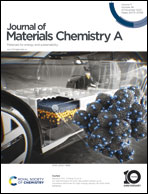Determination of the ion-conduction properties of Na3OBr and its dominant defect species†
Abstract
Antiperovskite materials have attracted significant attention as solid electrolytes for all-solid-state Li+/Na+-ion batteries because of their high conductivity and electrochemical stability. However, the synthesis of Na-rich antiperovskites (such as Na3OBr and Na3OCl) is challenging because it involves the purification of Na2O. Although the conductivity of Na3OBr has been extensively studied, the pellet microstructure is not described in sufficient detail, despite its significant impact on the conductivity of such systems. In this study, the Na2O2 impurities in commercial Na2O were reduced by Na metal using a 4 h purification process. Subsequently, non-doped, Ca2+-doped, and Br−-rich Na3OBr were fabricated using pure Na2O. Rietveld refinement and ab initio calculations confirmed Br−–O2− site mixing (rather than Schottky defects) to be the predominant defect species in undoped Na3OBr. Rietveld refinement confirmed the doping of Ca2+ ions into Na+ sites and excess Br− ions into O2− sites, with the introduction of Na+ vacancies for charge compensation. Uniaxial pressing produced Na3OBr pellets containing several pores, which remained after sintering. However, hot pressing caused effective pellet densification, producing Na3OBr pellets with a high relative density. The conductivity of Na3OBr decreased on Ca2+ doping and increased on substituting the O2− sites with excess Br−. The conductivities of sufficiently dense hot-pressed pellets were measured in a glovebox containing negligible O2/H2O, eliminating the influence of pellet pores and Na3OBr oxidation/hydration on the results. Therefore, these results represent the intrinsic conduction features of Na3OBr.



 Please wait while we load your content...
Please wait while we load your content...